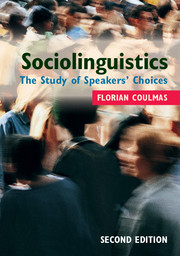Book contents
- Frontmatter
- Contents
- List of figures
- List of tables
- Preface to the second edition
- 1 Introduction: notions of language
- Part I Micro-choices
- 2 Standard and dialect: social stratification as a factor of linguistic choice
- 3 Gendered speech: sex as a factor of linguistic choice
- 4 Communicating across generations: age as a factor of linguistic choice
- 5 Choice and change
- 6 Politeness: cultural dimensions of linguistic choice
- Part II Macro-choices
- Glossary of terms
- References
- Index
- References
5 - Choice and change
Published online by Cambridge University Press: 05 August 2013
- Frontmatter
- Contents
- List of figures
- List of tables
- Preface to the second edition
- 1 Introduction: notions of language
- Part I Micro-choices
- 2 Standard and dialect: social stratification as a factor of linguistic choice
- 3 Gendered speech: sex as a factor of linguistic choice
- 4 Communicating across generations: age as a factor of linguistic choice
- 5 Choice and change
- 6 Politeness: cultural dimensions of linguistic choice
- Part II Macro-choices
- Glossary of terms
- References
- Index
- References
Summary
They say that time changes things, but you actually have to change them yourself.
Andy WarholCertaynly it is harde to playse every man, by cause of dyversité and change of language.
William Caxton (1422–91), Prologue to Eneydos‘To travel through Time!’ exclaimed the Very Young Man. … ‘One might get one’s Greek from the very lips of Homer and Plato,’ the Very Young Man thought.
H. G. Wells, The Time MachineOutline of the chapter
In this chapter language change through time is introduced as a major dimension of linguistic variation. First, it lays the theoretical and methodological foundations of studying language change from a sociolinguistic point of view, discussing the question of what the transmission of a language from one generation to the next and the incremental change it undergoes in the process imply for our notion of what a language is. Age-grading, the fact that coexisting speakers of different generations use language differently, is explained, and the construct of ‘apparent time’ is introduced as a technique of investigating language change while compensating for the paucity of recorded speech data from former times. To illustrate phonological adjustments in the course of dialect levelling, standardization and other alterations, surveys of several speech communities are adduced, and the influence on language change of gender and age is examined. The chapter concludes with a brief discussion of demographic change, a so far largely unexplored factor of language change that is of potential interest for future research.
- Type
- Chapter
- Information
- SociolinguisticsThe Study of Speakers' Choices, pp. 79 - 98Publisher: Cambridge University PressPrint publication year: 2013



